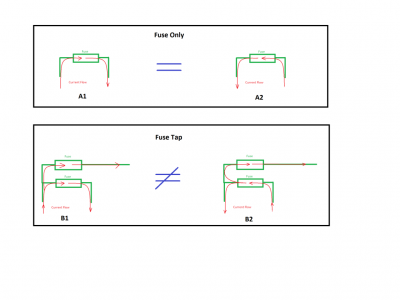So explain like I’m 5 what you mean by the fuse in parallel vs series, please. I have the same fuse pigtails and have used these before so I have some for this job. You tapped the heated steering wheel fuse?Here is mine setup. Main concern was high current for steering wheel heater and dash cam battery pack which charges at 9A and came with 20A fuse (20A + 20A). Because of the shape of fuse box I couldn't push the tap all the way down. Cannot say the connection was loose or flimsy, but just not full enough - which bothered me for some time. Finally I took the panels off and checked connections when both were at full power - temperature didn't go above 47C (ambient was ~17C). Considering I will use steering wheel heater mostly in winter - that should be good. Keep in mind that fuse tap orientation matters - fuses should be connected in parallel and not in series which could burn the bottom fuse in the fuse tap.
View attachment 26380
View attachment 26381
View attachment 26382
View attachment 26383
View attachment 26384
You are using an out of date browser. It may not display this or other websites correctly.
You should upgrade or use an alternative browser.
You should upgrade or use an alternative browser.
Fuse to tap dashcam?
- Thread starter Jeka
- Start date
Disclaimer: Links on this page pointing to Amazon, eBay and other sites may include affiliate code. If you click them and make a purchase, we may earn a small commission.
Here is a quick diagram:So explain like I’m 5 what you mean by the fuse in parallel vs series, please. I have the same fuse pigtails and have used these before so I have some for this job. You tapped the heated steering wheel fuse?

A1 and A2 scenarios are for Fuse only (factory stock) - it doesn't matter how you insert it.
B1 and B2 - when you add a Fuse Tap:
B1 - fuses are in parallel and each fuse has only it's own load.
B2 - the bottom fuse has to hold it's own load and whatever you tap into it. If your tapped equipment will be power hungry you can overload the circuit and the bottom fuse will blow.
Well, I did not know that orientation mattered when using the fuse pigtail thing... so how would one know what direction the flow is going?Here is a quick diagram:
View attachment 26410
A1 and A2 scenarios are for Fuse only (factory stock) - it doesn't matter how you insert it.
B1 and B2 - when you add a Fuse Tap:
B1 - fuses are in parallel and each fuse has only it's own load.
B2 - the bottom fuse has to hold it's own load and whatever you tap into it. If your tapped equipment will be power hungry you can overload the circuit and the bottom fuse will blow.
The best way to find out, is to take off the fuse and check both connections in the fuse box with voltmeter for DC power. One which has 12 volt is a source*, second with no power is destination.Well, I did not know that orientation mattered when using the fuse pigtail thing... so how would one know what direction the flow is going?
*you might need to turn on car full accessory power to power some fuses.
Another way to check: insert a fuse tap with just upper fuse installed, no bottom fuse - if they are in parallel your tapped accessory (dashcam, or whatever you connected) should have power.
Last edited:
This sounds easy enough, thanks!The best way to find out, is to take off the fuse and check both connections in the fuse box with voltmeter for DC power. One which has 12 volt is a source*, second with no power is destination.
*you might need to turn on car full accessory power to power some fuses.
Another way to check: insert a fuse tap with just upper fuse installed, no bottom fuse - if they are in parallel your tapped accessory (dashcam, or whatever you connected) should have power.
So it’s been some time, how has this been working for you? Any connectivity issues?Here is mine setup. Main concern was high current for steering wheel heater and dash cam battery pack which charges at 9A and came with 20A fuse (20A + 20A). Because of the shape of fuse box I couldn't push the tap all the way down. Cannot say the connection was loose or flimsy, but just not full enough - which bothered me for some time. Finally I took the panels off and checked connections when both were at full power - temperature didn't go above 47C (ambient was ~17C). Considering I will use steering wheel heater mostly in winter - that should be good. Keep in mind that fuse tap orientation matters - fuses should be connected in parallel and not in series which could burn the bottom fuse in the fuse tap.
View attachment 26380
View attachment 26381
View attachment 26382
View attachment 26383
View attachment 26384
marlinpruett
Full Access Members
Use the mirror tap
I’ve read through that particular thread but it may exceed my very limited skill when it comes to things with wires... is there actual cutting involved?Use the mirror tap
marlinpruett
Full Access Members
Last edited:
So far it’s been working perfectly fine.So it’s been some time, how has this been working for you? Any connectivity issues?
Similar threads
- Replies
- 0
- Views
- 963
- Replies
- 20
- Views
- 6K

